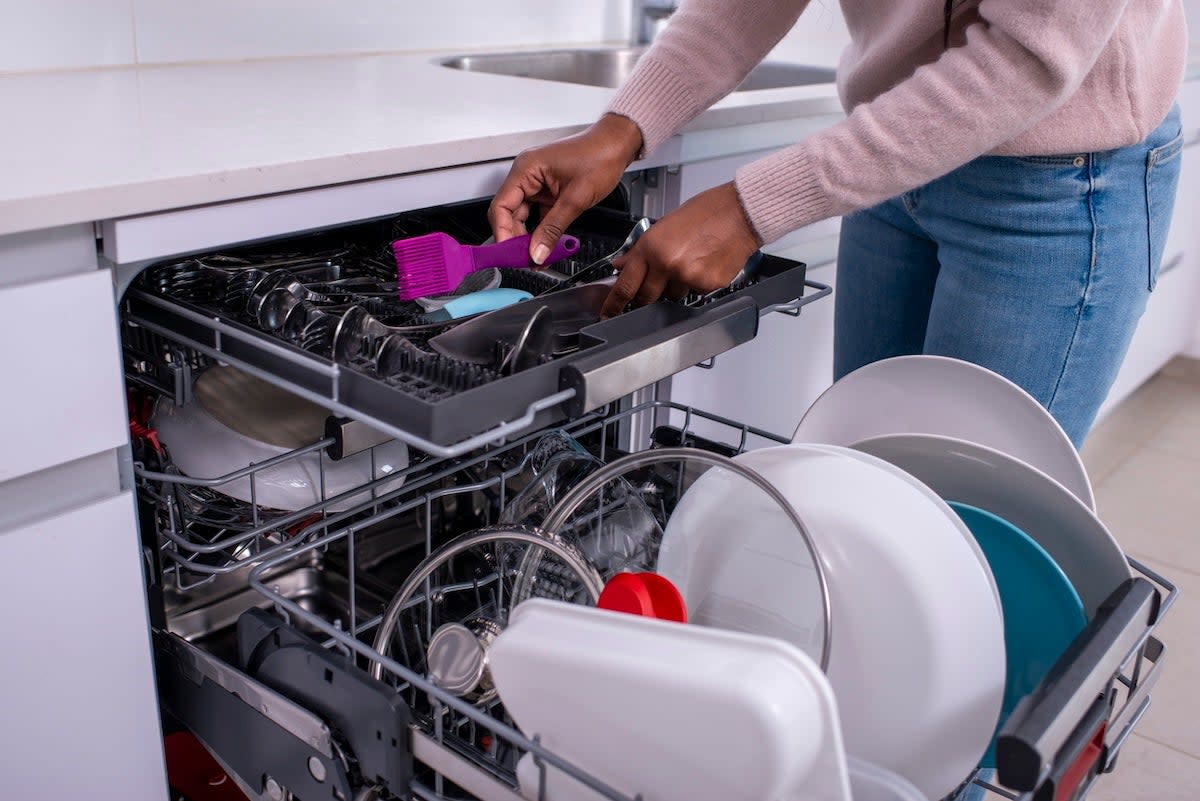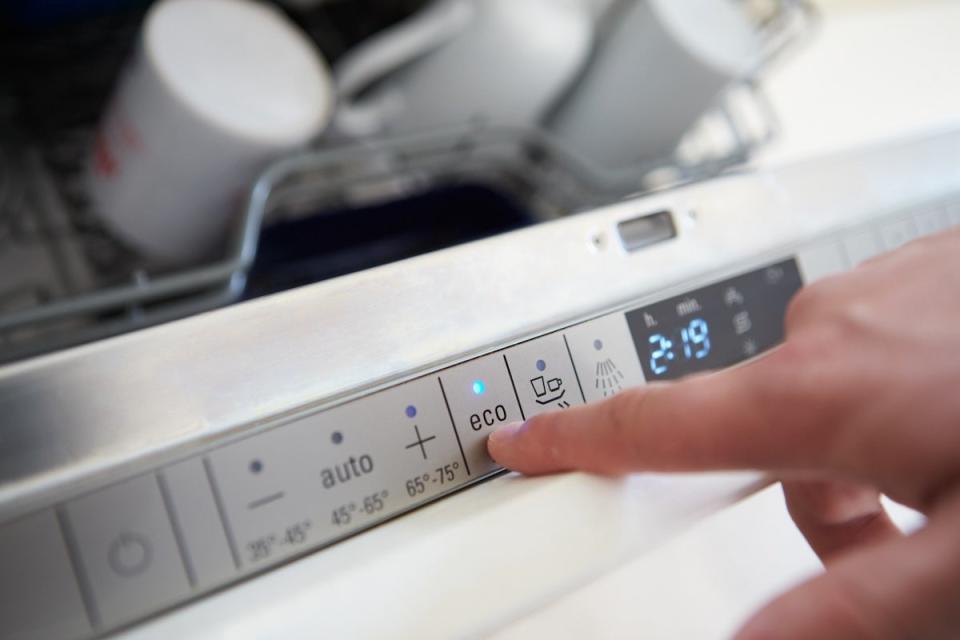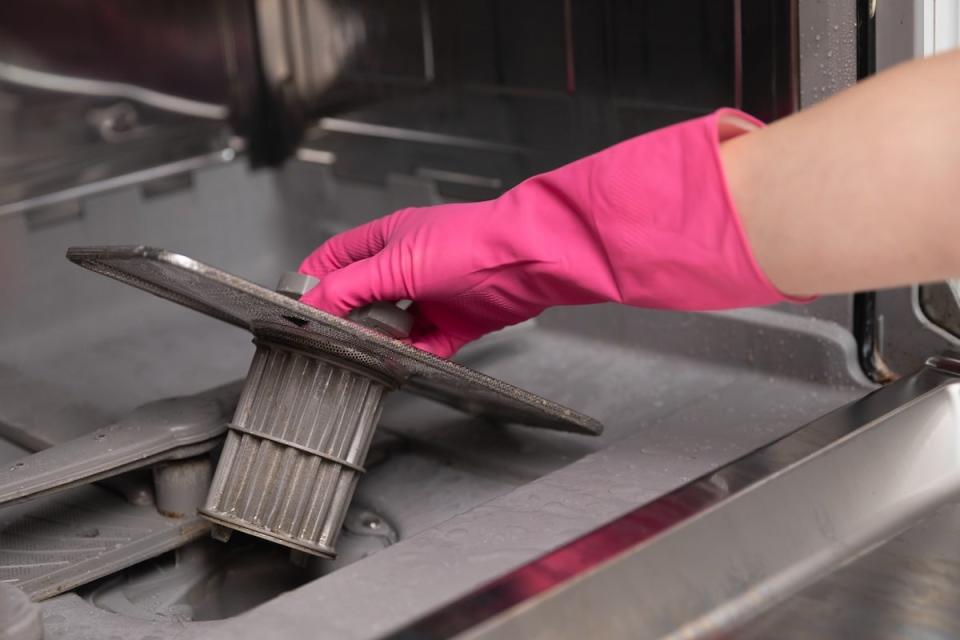How Much Water Does a Dishwasher Use?

Q: I moved into a house with existing appliances, including a dishwasher, and my first water bill was much higher than I expected. I’ve heard that dishwashers use more water than hand-washing, especially older dishwasher models. Before I replace or entirely remove the dishwasher, how much water does a dishwasher use? Do dishwashers use less water than hand-washing?
A: Thinking about how much water a dishwasher uses is a good place to start when building your budget for utility bills. A dishwasher is a large home appliance, so it isn’t unreasonable to assume that it consumes more water than hand-washing per load. However, hand-washing dishes can actually use as much as 27 gallons of water, while even older dishwasher models will only use as much as 16 gallons—and most use far less.
Newer dishwasher models of the past decade use even less water at a maximum of 5 gallons per load due to changes in energy and water conservation standards. And if a dishwasher model is Energy Star certified, then it could use as little as 3 gallons of water per load.
Dishwasher water usage varies by brand, model, and your appliance’s age.
It would be convenient if every dishwasher made used the exact same amount of water per cycle, but that isn’t the case. Dishwasher water usage differs depending on the appliance brand, model, and age of the appliance. Older dishwashers made before 2013 may use between 6 and 16 gallons of water per cycle. Meanwhile, as stated above, new dishwashers made after 2013 only use up to 5 gallons of water per load and Energy Star dishwashers use closer to 3 gallons per load.
Larger dishwasher models will generally use more water than compact dishwashers, so if there is only one or two people living in a home, a compact dishwasher is likely a better option than a standard dishwasher. It’s also a good idea to research brand-specific dishwasher facts and model specifications to find a make and model that fit your needs and desired water usage.
Dishwasher Brand | Average Water Usage (gallons per cycle) |
Avanti | 3.10 |
Beko | 2.59 |
Blomberg | 2.69 |
Bosch | 3.15 |
Electrolux | 2.65 |
Fulgor Milano | 2.70 |
Furrion | 3.10 |
Gaggenau | 2.97 |
Hestan | 2.80 |
Kenmore | 3.19 |
KOVA Select | 3.10 |
LG | 2.86 |
Signature Kitchen Suite | 2.77 |
Smeg | 2.95 |
Viking | 2.58 |
Using the dishwasher instead of hand-washing dishes saves a significant amount of water.
Do dishwashers save water? What are the actual differences between dishwasher vs. hand-washing water usage? These are common questions homeowners ask, and the answers are simple for both. Hand-washing seems like it wouldn’t use much water because the faucet can be turned off with the twist of a handle, while the average dishwasher run time can range from 1.5 to four full hours.
Despite this, dishwashers use much less water—as much as 24 gallons fewer—than hand-washing because of the nature of how these appliances work. On average, hand-washing will use up to 27 gallons of water, while a dishwasher typically uses somewhere between 3 and 16 gallons.
Dishwashers also come with a variety of settings meant to be adjusted according to the contents of a load. These appliances can even run without hot water, though this isn’t recommended because the hot water helps to kill bacteria, fungi, and viruses. Since dishwashers can heat the water to a higher temperature than you would use for hand-washing, they are also considered more sanitary.

Photo: istockphoto.com
Replacing an older dishwasher with an Energy Star dishwasher is worth the upgrade.
Old dishwasher models were not made to the same water-saving specifications as new Energy Star dishwashers, so it’s a good idea to replace an older dishwasher with a new Energy Star model. The cost to run a dishwasher ranges from about $0.24 to $0.38 per hour, or about $7.20 to $11.52 per month. This works out to about $86.40 to $138.24 per year, but an Energy Star dishwasher will only cost about $55 per year to operate, an average electric bill savings of about $60.
Beyond straightforward cost savings, an Energy Star dishwasher may also come with a variety of high-end features, like soil sensors, improved rack designs, upgraded water jets, or enhanced filtration capabilities, that old dishwashers lack. These can potentially help with efficiency, too, but they’re also quality upgrades in terms of usability and convenience.
Here’s how to use your dishwasher as efficiently as possible.
Since dishwasher water usage differs between brands, models, and cycles, it’s always recommended to read your appliance’s owner manual for guidance on how to use it the most effectively. That said, there are several universal dishwasher tips you can follow to maximize the efficiency and effectiveness of yours.
Scrape any food debris from dishes into the garbage before loading, but don’t pre-rinse. The vast majority of dishes do not need to be rinsed off before being put into the dishwasher, so skipping pre-rinsing will reduce unnecessary water consumption.
Don’t start a wash cycle until the dishwasher is full. While you can run a dishwasher that’s half-full, doing so wastes gallons of water.
Select an eco-friendly wash setting to reduce the amount of water used per cycle. Typically, this means choosing shorter cycle options and turning off unnecessary ones, but some models may have dedicated cycle options for saving energy.
Plan your dishwasher loads around the time of day. The best time to run a dishwasher is during off-peak hours: in the evening, early morning, or at night. Using water and electricity during off-peak hours helps to keep the energy and water costs down.
Regularly clean the dishwasher. Food waste, oils, and other debris will get stuck in the bottom of the dishwasher. Clean out the internal lining and dishwasher filter regularly to extend the lifespan of the dishwasher and increase the cleaning efficiency.
Use high-quality dish detergent to ensure dishes get sufficiently clean the first time around.
Air dry dishes after washing instead of using the dry cycle of the machine will further reduce energy consumption.

Photo: istockphoto.com
Final Thoughts
Using your dishwasher is the best way to wash and sanitize dishes without wasting a significant amount of water with hand-washing. However, it’s important to know how to use a dishwasher and how to keep the dishwasher properly maintained to ensure that it operates as efficiently as possible.
Unavoidably, though, some items should be hand-washed, such as insulated mugs, nonstick pans, and cast iron cookware. If these items are washed in a dishwasher, there is a chance that the dishwasher could damage them, or the dishwasher itself may end up damaged. And when in doubt, always read and follow the directions provided in your appliance owner manual for the best results.
About the Author
Timothy spent his post-secondary education years working in the plumbing trade while completing degrees in English literature and psychology. As a plumbing project manager, he had a wide range of work that included plumbing, carpentry, and electrical, as well as restoration work, appliance repair, and appliance installation. This allowed Timothy to greatly broaden his knowledge base, skills, and expertise in a variety of fields.

